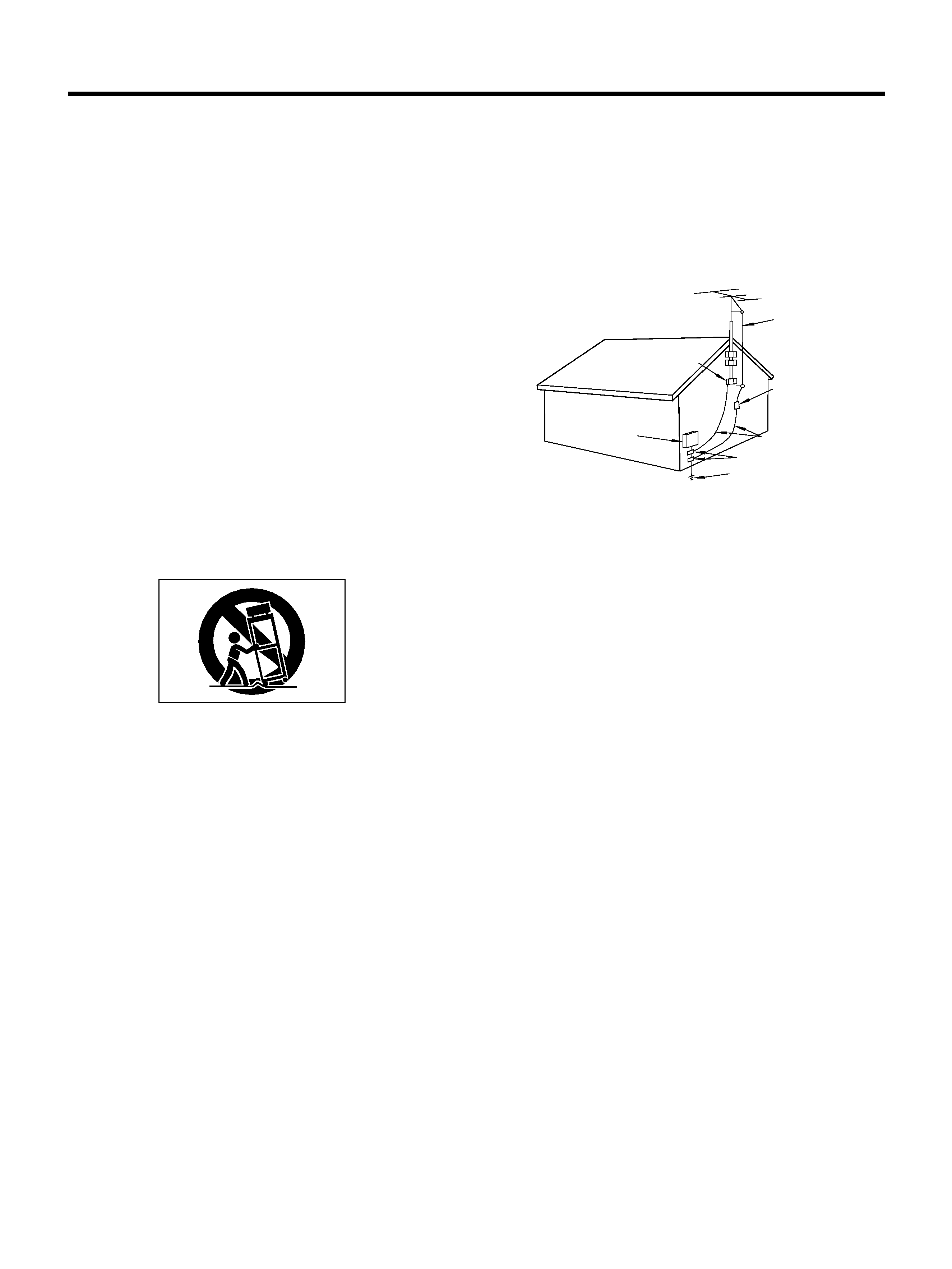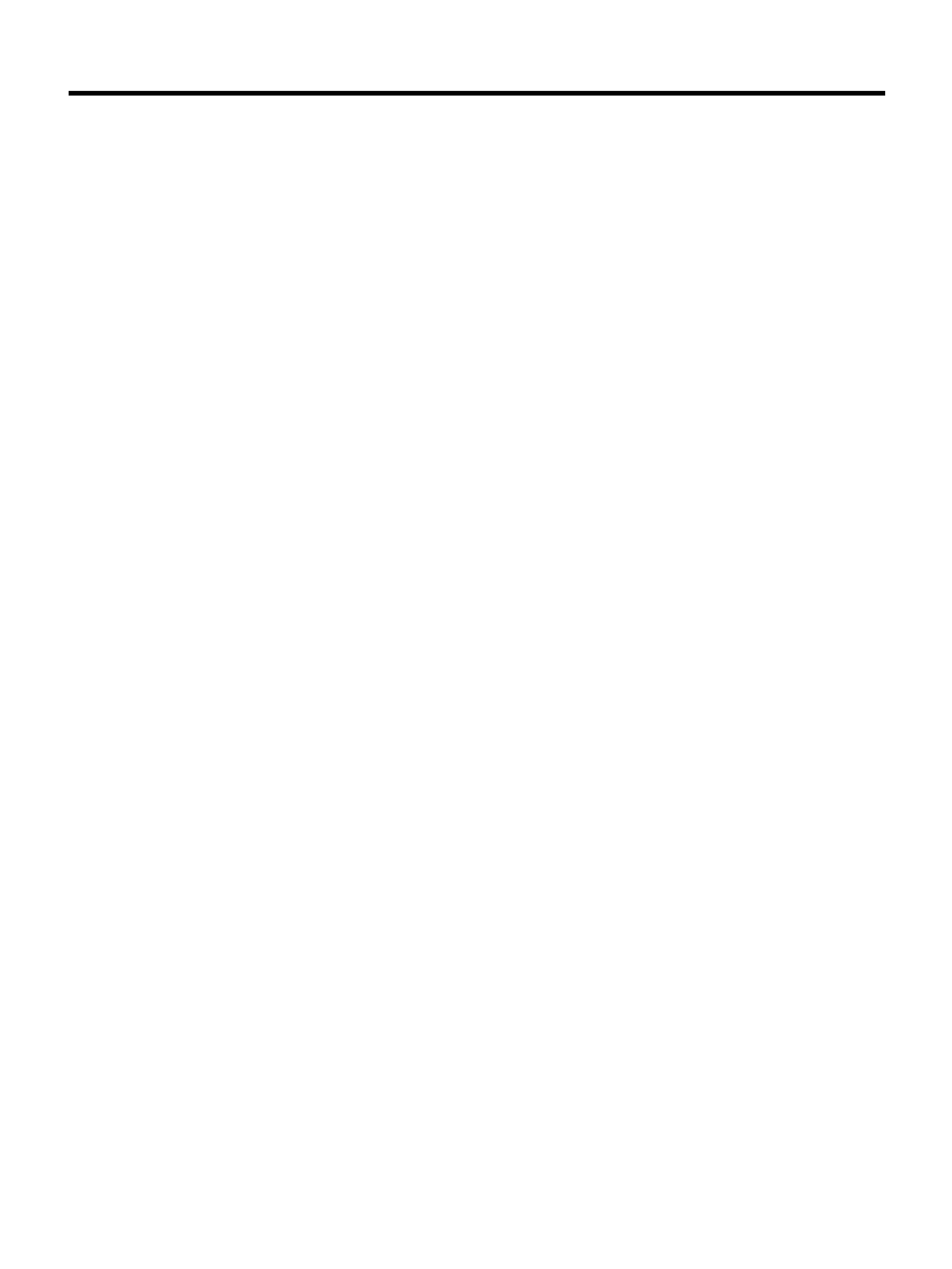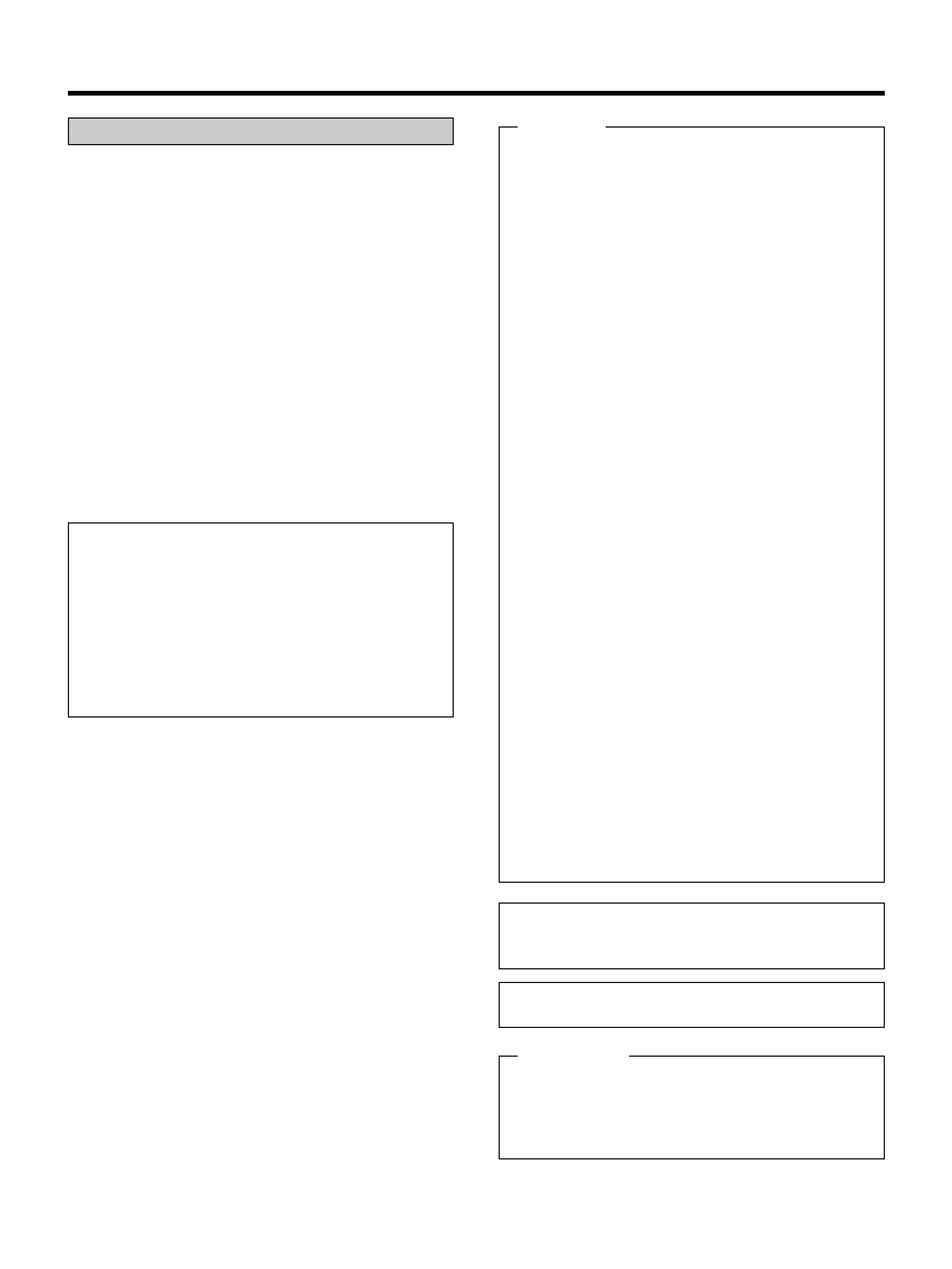
ag-780
`
AM/FM Stereo Receiver
9A08737200
WARNING: TO PREVENT FIRE OR SHOCK HAZARD, DO NOT EXPOSE
THIS APPLIANCE TO RAIN OR MOISTURE.
The exclamation point within an equilateral triangle is intended to alert the user to the pres-
ence of important operating and maintenance (servicing) instructions in the literature
accompanying the appliance.
The lightning flash with arrowhead symbol, within an equilateral triangle, is intended to alert
the user to the presence of uninsulated "dangerous voltage" within the product's enclosure
that may be of sufficient magnitude to constitute a risk of electric shock to persons.
CAUTION: TO REDUCE THE RISK OF ELECTRIC SHOCK, DO NOT
REMOVE COVER (OR BACK). NO USER-SERVICEABLE PARTS INSIDE.
REFER SERVICING TO QUALIFIED SERVICE PERSONNEL.
Ü
ÿ
Y
Thanks for buying a TEAC. Read this manual carefully to get the best performance from this unit.
Nous vous remercions pour l'achat d'un appareil TEAC.
Lire ce manuel avec attention pour obtenir les meilleures performances possibles de cet appareil.
OWNER'S MANUAL........................................... 3
MANUEL DUPROPRIETAIRE......................... 18

IMPORTANT SAFETY INSTRUCTIONS
2
CAUTION:
· Read all of these Instructions.
· Save these Instructions for later use.
· Follow all Warnings and Instructions marked on the audio
equipment.
1) Read Instructions -- All the safety and operating instructions
should be read before the product is operated.
2) Retain Instructions -- The safety and operating instructions
should be retained for future reference.
3) Heed Warnings -- All warnings on the product and in the oper-
ating instructions should be adhered to.
4) Follow Instructions -- All operating and use instructions should
be followed.
5) Cleaning -- Unplug this product from the wall outlet before
cleaning. Do not use liquid cleaners or aerosol cleaners. Use a damp
cloth for cleaning.
6) Attachments -- Do not use attachments not recommended by
the product manufacturer as they may cause hazards.
7) Water and Moisture -- Do not use this product near water _ for
example, near a bath tub, wash bowl, kitchen sink, or laundry tub; in
a wet basement; or near a swimming pool; and the like.
8) Accessories -- Do not place this product on an unstable cart,
stand, tripod, bracket, or table. The product may fall, causing serious
injury to a child or adult, and serious damage to the product. Use
only with a cart, stand, tripod, bracket, or table recommended by the
manufacturer, or sold with the product. Any mounting of the product
should follow the manufacturer's instructions, and should use a
mounting accessory recommended by the manufacturer.
9) A product and cart combination should be moved with care.
Quick stops, excessive force, and uneven surfaces may cause the
product and cart combination to overturn.
"Note to CATV system installer:
This reminder is provided to call the CATV system installer's atten-
tion to Section 820-40 of the NEC which provides guidelines for
proper grounding and, in particular, specifies that the cable ground
shall be connected to the grounding system of the building, as close
to the point of cable entry as practical."
ANTENNA
LEAD IN
WIRE
ANTENNA
DISCHARGE UNIT
(NEC SECTION 810-20)
G
ROUNDING CONDUCTORS
(NEC SECTION 810-21)
GROUND CLAMPS
POWER SERVICE GROUNDING
ELECTRODE SYSTEM
(NEC ART 250. PART H)
NEC - NATIONAL ELECTRICAL CODE
ELECTRIC
SERVICE
EQUIPMENT
Example of Antenna Grounding as per
National Electrical Code, ANSI/NFPA 70
GROUND
CLAMP
15) Lightning -- For added protection for this product during a light-
ning storm, or when it is left unattended and unused for long periods
of time, unplug it from the wall outlet and disconnect the antenna or
cable system. This will prevent damage to the product due to light-
ning and power-line surges.
16) Power Lines -- An outside antenna system should not be locat-
ed in the vicinity of overhead power lines or other electric light or
power circuits, or where it can fall into such power lines or circuits.
When installing an outside antenna system, extreme care should be
taken to keep from touching such power lines or circuits as contact
with them might be fatal.
17) Overloading -- Do not overload wall outlets, extension cords, or
integral convenience receptacles as this can result in risk of fire or
electric shock.
18) Object and Liquid Entry -- Never push objects of any kind into
this product through openings as they may touch dangerous voltage
points or short-out parts that could result in a fire or electric shock.
Never spill liquid of any kind on the product.
19) Servicing -- Do not attempt to service this product yourself as
opening or removing covers may expose you to dangerous voltage
or other hazards. Refer all servicing to qualified service personnel.
20) Damage Requiring Service -- Unplug this product from the
wall outlet and refer servicing to qualified service personnel under
the following conditions:
a) when the power-supply cord or plug is damaged.
b) if liquid has been spilled, or objects have fallen into the product.
c) if the product has been exposed to rain or water.
d) if the product does not operate normally by following the operat-
ing instructions. Adjust only those controls that are covered by the
operating instructions as an improper adjustment of other controls
may result in damage and will often require extensive work by a qual-
ified technician to restore the product to its normal operation.
e) if the product has been dropped or damaged in any way.
f ) when the product exhibits a distinct change in performance _ this
indicates a need for service.
21) Replacement Parts -- When replacement parts are required,
be sure the service technician has used replacement parts specified
by the manufacturer or have the same characteristics as the original
part. Unauthorized substitutions may result in fire, electric shock, or
other hazards.
22) Safety Check -- Upon completion of any service or repairs to
this product, ask the service technician to perform safety checks to
determine that the product is in proper operating condition.
23) Wall or Ceiling Mounting -- The product should be mounted to
a wall or ceiling only as recommended by the manufacturer.
24) Heat -- The product should be situated away from heat sources
such as radiators, heat registers, stoves, or other products (includ-
ing amplifiers) that produce heat.
10) Ventilation -- Slots and openings in the cabinet are provided
for ventilation and to ensure reliable operation of the product and to
protect it from overheating, and these openings must not be blocked
or covered. The openings should never be blocked by placing the
product on a bed, sofa, rug, or other similar surface. This product
should not be placed in a built-in installation such as a bookcase or
rack unless proper ventilation is provided or the manufacturer's
instructions have been adhered to.
11) Power Sources -- This product should be operated only from
the type of power source indicated on the marking label. If you are
not sure of the type of power supply to your home, consult your prod-
uct dealer or local power company. For products intended to oper-
ate from battery power, or other sources, refer to the operating
instructions.
12) Grounding or Polarization -- This product may be equipped
with a polarized alternating-current line plug (a plug having one
blade wider than the other). This plug will fit into the power outlet
only one way. This is a safety feature. If you are unable to insert the
plug fully into the outlet, try reversing the plug. If the plug should still
fail to fit, contact your electrician to replace your obsolete outlet. Do
not defeat the safety purpose of the polarized plug.
13) Power-Cord Protection -- Power-supply cords should be rout-
ed so that they are not likely to be walked on or pinched by items
placed upon or against them, paying particular attention to cords at
plugs, convenience receptacles, and the point where they exit from
the product.
14) Outdoor Antenna Grounding -- If an outside antenna or
cable system is connected to the product, be sure the antenna or
cable system is grounded so as to provide some protection against
voltage surges and built-up static charges. Article 810 of the
National Electrical Code, ANSI/NFPA 70, provides information with
regard to proper grounding of the mast and supporting structure,
grounding of the lead-in wire to an antenna discharge unit, size of
grounding
conductors,
location
of
antenna-discharge
unit,
connection to grounding electrodes, and requirements for the
grounding electrode.

CONTENTS
3
IMPORTANT SAFETY INSTRUCTIONS ............................................................................................................2
PRECAUTIONS
Read This Before Operating .........................................................................................................................4
CONNECTIONS
System Connections......................................................................................................................................5
Antenna Connections
FM Indoor Antenna ...................................................................................................................................6
FM Outdoor Antenna ................................................................................................................................6
AM Antenna...............................................................................................................................................6
Speaker Connections.....................................................................................................................................7
AC OUTLET ....................................................................................................................................................7
CONTROLS AND INDICATORS .........................................................................................................................8
REMOTE CONTROL UNIT
Using the Remote Control Unit ..................................................................................................................10
Battery Installation.......................................................................................................................................10
AUDIO OPERATIONS
Back-up Memory Function..........................................................................................................................11
Sleep Timer Operation ................................................................................................................................11
Basic Operations..........................................................................................................................................11
Audio Adjustments .................................................................................................................................12
Radio Reception
Auto Tuning .............................................................................................................................................12
Manual Tuning ........................................................................................................................................13
Preset Tuning
Manual Memory Presetting....................................................................................................................13
Listening to Source .....................................................................................................................................14
Listening to Tape .........................................................................................................................................14
Recording a Source .....................................................................................................................................15
Reset .............................................................................................................................................................15
TROUBLESHOOTING .......................................................................................................................................16
SPECIFICATIONS..............................................................................................................................................17

4
WARNING
Changes or modifications to this unit not expressly
approved by the party responsible for compliance
could void the user's authority to opoerate the
equipement.
NOTE: This equipement has been tested and found
to comply with the limits for a Class B digital
device, pursuant to Part 15 of the FCC Rules. These
limits are designed to provide reasonable protec-
tion against harmful interference in a residential
installation. This equipement generates, uses, and
can radiate radio frequency energy and, if not
installed and used in accordance with the instruc-
tions, may cause harmful interference to radio
communications. However, there is no guarantee
that interference will not occure in a particular
installation. If this equipement does cause harmful
interference to radio or television reception, which
can be determinedby turning the equipement off
and on, the user is encouraged to try to correct the
interference by one or more of the following mea-
sures:
Reorient or relocate the receiving antenna.
Increase the separation between the equipement
and receiver.
Connect the equipement into an outlet on a circuit
different from that to which the receiver is con-
nected.
Consult the dealer or an experienced radio TV
technician for help.
Shielded cables must be used with this unit to
ensure compliance with the Class B FCC limits.
CAUTION
Changes or modifications to this equipment not
expressly approved by TEAC CORPORATION for
compliance could void the user's authority to oper-
ate this equipment.
For U.S.A.
The equipment draws nominal non-operating
power from the AC outlet with its POWER switch in
the STANDBY position.
Obs! nätströmställare ¨n skiljer ej hela apparaten
från nätet.
AC POWER CORD CONNECTION
CAUTION:
TO PREVENT ELECTRIC SHOCK, MATCH WIDE
BLADE OF PLUG TO WIDE SLOT, FULLY INSERT.
For CANADA
Choose the installation location of your unit carefully.
Avoid placing it in direct sunlight or close to a source
of heat. Also avoid locations subject to vibrations and
excessive dust, heat, cold or moisture.
The ventilation holes should not be covered. Make
sure there is at least 10 cm (4 inches) of space above
and at least 10 cm (4 inches) of space beside the ampli-
fier/receiver. Do not place a CD player or other equip-
ment on top of the amplifier/receiver.
Do not open the cabinet as this might result in damage
to the circuitry or electrical shock. If a foreign object
should get into the set, contact your dealer.
When removing the power plug from the wall outlet,
always pull directly on the plug, never yank the cord.
Do not attempt to clean the unit with chemical sol-
vents as this might damage the finish. Use a clean, dry
cloth.
Keep this manual in a safe place for future reference.
Read This Before Operating
CAUTION Regarding Placement
(Except for U.S.A. and Canada)
To maintain proper ventilation, be sure to leave a
space around the unit (from the largest outer
dimensions including projections) equal to, or
greater than, shown below.
Left and Right Panels
: 10 cm
Rear Panel
: 10 cm
Top Panel
: 10 cm
PRECAUTIONS

CONNECTIONS
System Connections
: Audio signal
5
CAUTION: Do not plug the power cord of any component
into AC outlets and do not turn their POWER switches on
until all connections have been performed.
To AC outlet
Refer to "Antenna Connections" on pages 6.
Turntable
Tape Deck
VIDEO
Audio connection cords
CD Player
AC Outlet:
Unswitched, Total 100W.
LINE
IN
AUDIO
OUT
LINE
OUT
White
White
White
Red
Red
Red
L
L
RR
Speaker B
Speaker A
